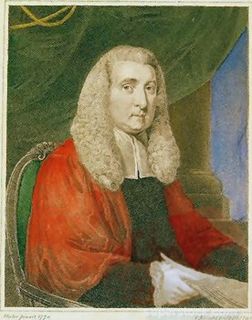Related Research Articles

Thomas Stanley, 1st Earl of Derby, KG was an English nobleman and politician. He was a titular King of Mann, and stepfather to King Henry VII of England. He was the eldest son of Thomas Stanley, 1st Baron Stanley and Joan Goushill.

Daines Barrington, FRS, FSA was an English lawyer, antiquary and naturalist. He was one of the correspondents to whom Gilbert White wrote extensively on natural history topics. Barrington served as a Vice President of the Royal Society and wrote on a range of topics related to the natural sciences including early ideas and scientific experimentation on the learning of songs by young birds. He designed a standard format for the collection of information about weather, the flowering of plants, the singing of birds and other annual changes that was also used by Gilbert White. He also wrote on child geniuses including Mozart, who at the age of nine had visited England.

Reverend John Thomas Romney Robinson FRS FRSE DD DCL LLD, usually referred to as Thomas Romney Robinson, was a 19th-century astronomer and physicist. He was the longtime director of the Armagh Astronomical Observatory, one of the chief astronomical observatories in the UK of its time.

Francis Lovell, 9th Baron Lovell, 6th Baron Holand, later 1st Viscount Lovell KG was an English nobleman who was an ally of King Richard III during the War of the Roses. Sir William Catesby, Sir Richard Ratcliffe and he were among Richard's closest supporters, famously called "the Cat, the Rat and Lovell our dog" in an anti-Ricardian squib. In addition to being an ally, Lovell is attributed as Richard's best friend.

The Battle of Flodden, Flodden Field, or occasionally Branxton was a battle fought on 9 September 1513 during the War of the League of Cambrai between the Kingdom of England and the Kingdom of Scotland, resulting in an English victory. The battle was fought in Branxton in the county of Northumberland in northern England, between an invading Scots army under King James IV and an English army commanded by the Earl of Surrey. In terms of troop numbers, it was the largest battle fought between the two kingdoms. James IV was killed in the battle, becoming the last monarch from the British Isles to die in battle.

Anthony Wood, who styled himself Anthony à Wood in his later writings, was an English antiquary.

The Society of Antiquaries of London (SAL) is a learned society "charged by its Royal Charter of 1751 with 'the encouragement, advancement and furtherance of the study and knowledge of the antiquities and history of this and other countries'." It is based at Burlington House, Piccadilly, London, and is a registered charity.

Sir William Hamilton,, was a British diplomat, antiquarian, archaeologist and vulcanologist. After a short period as a Member of Parliament, he served as British Ambassador to the Kingdom of Naples from 1764 to 1800. He studied the volcanoes Vesuvius and Etna, becoming a Fellow of the Royal Society and recipient of the Copley Medal. His second wife was Emma Hamilton, famed as Horatio Nelson's mistress.

Penrith castle is a now-ruined medieval castle located in Penrith, in the north-west of England, a few miles to the east of the Lake District National Park.
John Holt was an English author.
Edward Horton Hubbard was an English architectural historian who worked with Nikolaus Pevsner in compiling volumes of the Buildings of England. He also wrote the definitive biography of John Douglas, and played a part in the preservation of Albert Dock in Liverpool.

The Wars of the Roses were a series of English civil wars for control of the throne of England fought between supporters of two rival cadet branches of the royal House of Plantagenet: the House of Lancaster, represented by a red rose, and the House of York, represented by a white rose. Eventually, the wars eliminated the male lines of both families. The conflict lasted through many sporadic episodes between 1455 and 1487, but there was related fighting before and after this period between the parties. The power struggle ignited around social and financial troubles following the Hundred Years' War, unfolding the structural problems of bastard feudalism, combined with the mental infirmity and weak rule of King Henry VI which revived interest in the House of York's claim to the throne by Richard of York. Historians disagree on which of these factors was the main reason for the wars.

William Dacre, 2nd Baron Dacre was an English peer. In the final months of his life he was also 3rd Baron Multon of Gilsland. In some sources he is called William de Dacre.
Owen Salusbury Brereton,, born Owen Brereton, was an English antiquary.
John Trotter Brockett (1788-1842), was a British attorney, antiquarian, numismatist, and philologist.
North Ludlow Beamish, was an Irish military writer and antiquary.
The Banastre Rebellion was an uprising in Lancashire, England in 1315 against the Earl of Lancaster and his supporters. It took place in 1315 when a group of disaffected knights decided to revenge themselves on the Earl of Lancaster by attacking his chief retainer and their rival, Sir Robert de Holland. The group was led by Sir Adam Banastre of Bank Hall, Bretherton who had extensive landholdings in the county, Sir William de Bradshaigh of Haigh Hall and Sir Henry Lea of Charnock Richard. The cause of their grievance was that the powerful earl, the dominant force in the North-west of England, appeared to be favouring the Holland family to their disadvantage.
Henry Wansey was an English antiquary, who was by trade a clothier, but retired from business in middle life and devoted his leisure to travel, to literature, and to antiquarian research.
James Yates was an English Unitarian minister and scholar, known as an antiquary.
Sir Richard Clayton, 1st Baronet (1745–1828) was an English barrister and diplomat, remembered as a translator.
References
![]()